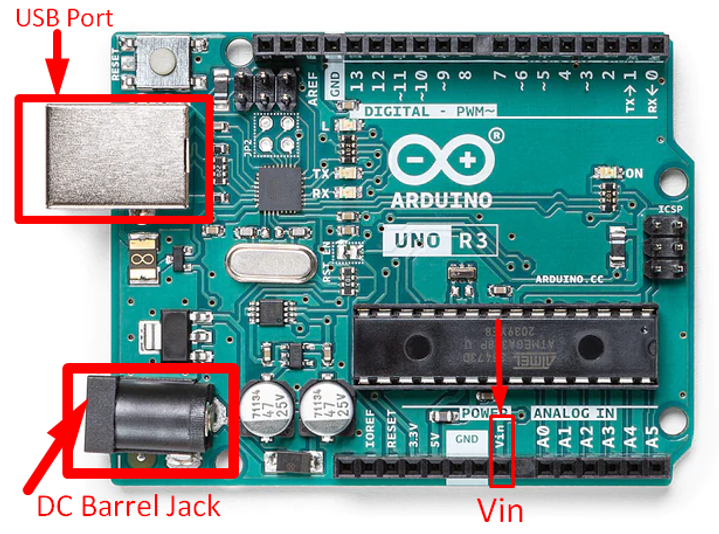What does Vcc Stands for in Arduino
Every electronic device needs power to run, the same is the case with Arduino. Vcc is the minimum power needed to operate Arduino efficiently. Vcc in Arduino refers to a regulated DC supply voltage required to run the ATMEGA328P used in Arduino boards as microcontroller.
Power Requirements for Arduino
Most of the Arduinos use “ATMEGA328P” microcontrollers which have a wide range of acceptable voltages Vcc. They are designed to work at two different levels 3.3V for low power consumption and 5V-16V for high power consumption such as mechanical motors and drivers.
Below I have shown Arduino board specification in term of voltage:
|
Power |
I/O Voltage | 5V |
| Input Voltage (nominal) | 7-12V | |
| DC Current I/O | 20mA | |
| Connector Type | Barrel Plug |
Arduino power goes in two ways:
-
- We provide input Vcc to Arduino to power it up.
- We can take voltage from Arduino and power some of our components by using Arduino voltage available at two pins giving us 5V and 3.3V.
Ways to Power Arduino Through Vcc
There are three ways to give power (Vcc) to Arduino. Each of these has some requirements in terms of using them in your circuit:
-
- USB port
- DC Barrel plug
- Vin Pin

Method 1: Vcc Through USB Port
The easiest and practical way of powering your Arduino is by using a USB serial port. It provides us with an exact regulated 5V supply. By using a USB power source, you do not need any external power source. The USB port has a built-in regulator; it does not use an Arduino board 5-volt regulator. USB 2.0 port can provide you current up to 500mA depending upon the need of a circuit.
Type of USB connector depends upon which Arduino board you are using. Arduino nano has USB mini-B connector Arduino UNO has USB type B connector. Below I have mentioned Voltage and Current limits for USB ports:
| Specifications | Value |
| Voltage | 5V |
| Current | 500mA |
Method 2: Vcc Through DC Barrel Jack
Another way of powering your Arduino is by the use of a 2.1mm barrel jack which comes as a standard with most of your Arduino boards. Arduino can accept a voltage up to 16V but the sweet spot lies between 7V-12V. It is recommended not to use voltage more than 16V as it can damage your board.
Tip: Don’t use voltage less than 6V because the 5V regulator is attached with a barrel jack which uses some voltages and dissipates some as heat. Another reason is that there is a diode linked with it which prevents electrical damage to your board in case you used Negative Vcc, so there will always be some voltages wasted in. Also don’t over power your Arduino like 12 or 15 volts through the DC jack, because at the end you will be getting 5V and you will be losing lots of your voltages in the form of heat. Voltage and currents limits describe here:
| Specifications | Value |
| Voltage | 7-12V |
| Current | Up to 800mA |
Method 3: Vcc Through Vin Pin of Arduino
Last way of powering your Arduino includes Vin port. By using Vin, we can also power Arduino with Vcc. Vin is directly connected to the Positive Terminal of DC barrel jack. Vin functions the same way as barrel jack and provides you with the same voltage levels as DC jack but lacks two features:
-
- No Diode which means no Reverse polarity protection available
- There will be no voltage drop due to absence of diode
Current and Voltage limits are the same as DC barrel jack:
| Specifications | Value |
| Voltage | 7-12V (+Vcc) |
| Current | Up to 800mA |
Can we use USB and DC Barrel Jack Together
Answer is YES. It all depends upon the required output voltages if the required voltages are greater than 6V then Arduino will be getting power from DC Barrel jack otherwise it will continue with USB port. Another thing to understand is if you are not getting power from USB, it doesn’t mean that your serial communication will stop, those will work fine, it’s just you are not getting power from USB anymore.
Conclusion
That’s it we have covered all the power sources available for Arduino. Best way to power your Arduino is by DC Barrel jack so we can take all the advantages of built-in safety features. But it all depends upon your needs. You can select a power source according to it if you have a system that requires continuous high voltage then a DC barrel jack will be for you or if your circuit has built in protections then a 5V USB port will be good for you.
Source: linuxhint.com
